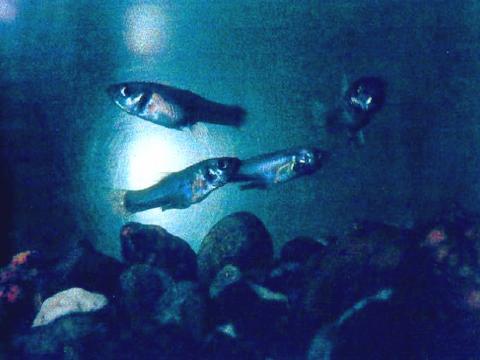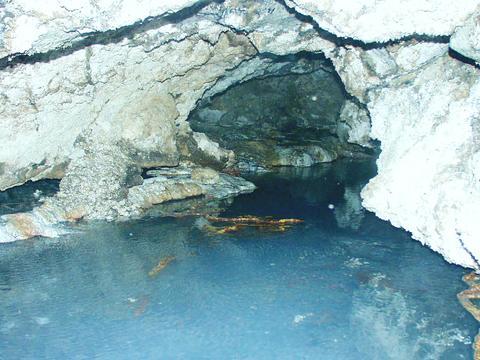In a long, crowded room stuffed full of small aquariums at the Zoological Institute of the University of Hamburg, oddities of the fish world swim back and forth behind glass to the background music of bubbling water.
Plucked from the pitch-black depths of caves around the world -- in Oman, Croatia, Brazil, Mexico -- many of these fish are blind, their unseeing eyes staring out, oblivious to the humans that stare in at them or the daylight that pours in the windows. Others are not only blind but eyeless, cruising along with their eerily blank heads alongside other bizarre-looking swimmers.

PHOTO: NY TIMES
Watching these queer creatures, anyone can understand why biologists have long studied the most striking of the physical changes -- like eyelessness and loss of coloration to near translucence -- that typically accompany the shift from daylight into eternal night. But such a focus has left much of life in caves a biological mystery.

PHOTO: NY TIMES
Now some scientists, including researchers in Hamburg, have begun looking beyond the gross physical changes to the subtleties of life in caves, in particular mating. How, for example, can a female fish wisely choose a mate she cannot see?
In new studies of the Atlantic molly, these scientists are finding that mate choice is so critical and that size is so important that cave-dwelling females have developed a way to assess potential mates without seeing or contacting them, consistently going for the bigger, better-fed males, even in complete darkness.
"It was a surprise," said Martin Plath, a graduate student who has carried out the work with fellow behavioral biologists at Hamburg, Jakob Parzefall, Kay Koerner and Ingo Schlupp. Noting that the mollies had probably colonized the cave recently, he said, "Sexual selection for size must be very strong."
But the new studies, some recently published in Behavioral Ecology and Sociobiology, are not merely investigations of cave curiosities. Researchers say the question is how animals adapt to major environmental change: the switch to cave living serving as a proxy for any number of changes, like warming environment or deteriorating habitat.
Nearly all Atlantic mollies, or Poecilia Mexicana, live in well-lighted streams and rivers. But in 1962, in the state of Tabasco, Mexico, scientists discovered what remains the only known population of the species living in a cave.
And it is a bizarre cave at that. The river flowing through it is a milky white from heavy concentrations of hydrogen sulfide. The sulfur causes the darkened cave and much of the nearby forest to reek of rotten eggs, and makes the slippery walls drip with
sulfuric acid.
The milky pools where these 1.5cm-long fish live stretch far back into the cave. They are slimy with unusual bacteria that require sulfur, not sunlight, to live. In fact, the air is so heavy with sulfur odors that researchers do not stay in the cave for more than an hour or two at a time.
"It's not that bad, though," Plath insisted, noting that a bit of contact with sulfuric acid could be quite good for the skin. "You just have to have someone waiting for you at the cave entrance, in case you don't come out."
The fish, their cave and the smelly, milky river flowing from it are so striking that they have become central to an annual rite of the people of the area: They drop a poisonous plant into the waters just inside the cave, Plath said, killing mollies that flow out of the cave. They then collect and eat the fish in a fertility-related rite, he said.
Back in Hamburg, the scientists tested the preferences of the cave females in darkness by watching them by video camera in infrared light. In some species of fish, the females make obvious signals that they prefer or disdain particular males, but the Atlantic mollies show their preferences by swimming longer near larger males and spending less time around smaller prospects.
Scientists suspect the cave mollies are using a sensory organ known as the lateral line -- a line of pores along the side that, like eardrums, can sense pressure changes -- to find the bigger males. Fish normally use the lateral line to detect objects, and all mollies have such a lateral line.
But scientists found that females from sunny streams were able to use their eyes only to assess which males were bigger and that those females were unable to use their lateral lines to detect the bigger males when given a choice in darkness.
While the cave females have had to evolve a novel way of detecting large mates, they enjoy an advantage in mating with the lights out.
Standing in front of a tank full of mollies from a surface stream population, Plath describes how these zippy males never stop trying to mate with females. Pointing to a large male darting madly after a female that is dashing away, he says, "That's a nip and another nip," referring to the repeated movement of the male's head toward the female in an effort to taste the female's chemical signals.
"There!" he says, pointing out a brief instant when a male swimming alongside a female tried to mate, an action so rapid that it was visible only to well-trained eyes.
"If you don't separate males and females, the females just die," Plath said. "Males constantly harass them. It's copulating, copulating, nothing but copulating and the females can't feed."
But life in caves has calmed the molly males, which do not harass females and are overall a more sluggish bunch than their light-dwelling counterparts. The reason, researchers say, is probably that in the dark, oxygen-poor waters of the cave, simply finding a female is an energy-intensive task, making harassment on top of that too costly.

June 23 to June 29 After capturing the walled city of Hsinchu on June 22, 1895, the Japanese hoped to quickly push south and seize control of Taiwan’s entire west coast — but their advance was stalled for more than a month. Not only did local Hakka fighters continue to cause them headaches, resistance forces even attempted to retake the city three times. “We had planned to occupy Anping (Tainan) and Takao (Kaohsiung) as soon as possible, but ever since we took Hsinchu, nearby bandits proclaiming to be ‘righteous people’ (義民) have been destroying train tracks and electrical cables, and gathering in villages

Dr. Y. Tony Yang, Associate Dean of Health Policy and Population Science at George Washington University, argued last week in a piece for the Taipei Times about former president Ma Ying-jeou (馬英九) leading a student delegation to the People’s Republic of China (PRC) that, “The real question is not whether Ma’s visit helps or hurts Taiwan — it is why Taiwan lacks a sophisticated, multi-track approach to one of the most complex geopolitical relationships in the world” (“Ma’s Visit, DPP’s Blind Spot,” June 18, page 8). Yang contends that the Democratic Progressive Party (DPP) has a blind spot: “By treating any

Swooping low over the banks of a Nile River tributary, an aid flight run by retired American military officers released a stream of food-stuffed sacks over a town emptied by fighting in South Sudan, a country wracked by conflict. Last week’s air drop was the latest in a controversial development — private contracting firms led by former US intelligence officers and military veterans delivering aid to some of the world’s deadliest conflict zones, in operations organized with governments that are combatants in the conflicts. The moves are roiling the global aid community, which warns of a more militarized, politicized and profit-seeking trend

This year will go down in the history books. Taiwan faces enormous turmoil and uncertainty in the coming months. Which political parties are in a good position to handle big changes? All of the main parties are beset with challenges. Taking stock, this column examined the Taiwan People’s Party (TPP) (“Huang Kuo-chang’s choking the life out of the TPP,” May 28, page 12), the Democratic Progressive Party (DPP) (“Challenges amid choppy waters for the DPP,” June 14, page 12) and the Chinese Nationalist Party (KMT) (“KMT struggles to seize opportunities as ‘interesting times’ loom,” June 20, page 11). Times like these can